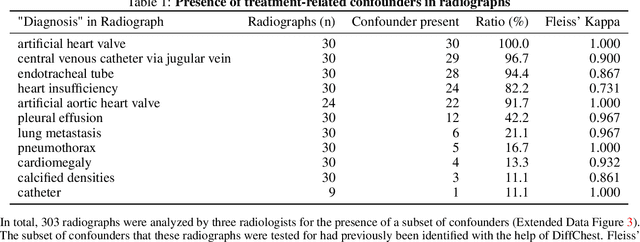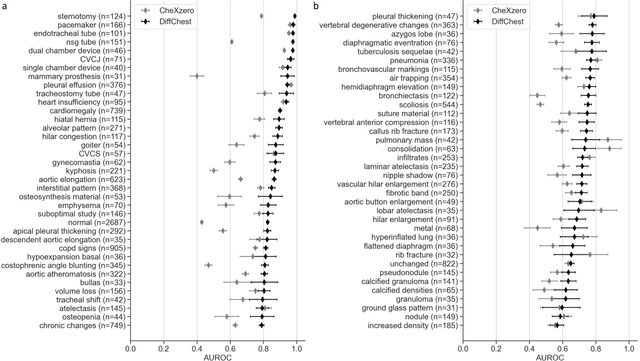Luisa Huck
Reconstruction of Patient-Specific Confounders in AI-based Radiologic Image Interpretation using Generative Pretraining
Sep 29, 2023



Abstract:Detecting misleading patterns in automated diagnostic assistance systems, such as those powered by Artificial Intelligence, is critical to ensuring their reliability, particularly in healthcare. Current techniques for evaluating deep learning models cannot visualize confounding factors at a diagnostic level. Here, we propose a self-conditioned diffusion model termed DiffChest and train it on a dataset of 515,704 chest radiographs from 194,956 patients from multiple healthcare centers in the United States and Europe. DiffChest explains classifications on a patient-specific level and visualizes the confounding factors that may mislead the model. We found high inter-reader agreement when evaluating DiffChest's capability to identify treatment-related confounders, with Fleiss' Kappa values of 0.8 or higher across most imaging findings. Confounders were accurately captured with 11.1% to 100% prevalence rates. Furthermore, our pretraining process optimized the model to capture the most relevant information from the input radiographs. DiffChest achieved excellent diagnostic accuracy when diagnosing 11 chest conditions, such as pleural effusion and cardiac insufficiency, and at least sufficient diagnostic accuracy for the remaining conditions. Our findings highlight the potential of pretraining based on diffusion models in medical image classification, specifically in providing insights into confounding factors and model robustness.
Fibroglandular Tissue Segmentation in Breast MRI using Vision Transformers -- A multi-institutional evaluation
Apr 18, 2023Abstract:Accurate and automatic segmentation of fibroglandular tissue in breast MRI screening is essential for the quantification of breast density and background parenchymal enhancement. In this retrospective study, we developed and evaluated a transformer-based neural network for breast segmentation (TraBS) in multi-institutional MRI data, and compared its performance to the well established convolutional neural network nnUNet. TraBS and nnUNet were trained and tested on 200 internal and 40 external breast MRI examinations using manual segmentations generated by experienced human readers. Segmentation performance was assessed in terms of the Dice score and the average symmetric surface distance. The Dice score for nnUNet was lower than for TraBS on the internal testset (0.909$\pm$0.069 versus 0.916$\pm$0.067, P<0.001) and on the external testset (0.824$\pm$0.144 versus 0.864$\pm$0.081, P=0.004). Moreover, the average symmetric surface distance was higher (=worse) for nnUNet than for TraBS on the internal (0.657$\pm$2.856 versus 0.548$\pm$2.195, P=0.001) and on the external testset (0.727$\pm$0.620 versus 0.584$\pm$0.413, P=0.03). Our study demonstrates that transformer-based networks improve the quality of fibroglandular tissue segmentation in breast MRI compared to convolutional-based models like nnUNet. These findings might help to enhance the accuracy of breast density and parenchymal enhancement quantification in breast MRI screening.
 Add to Chrome
Add to Chrome Add to Firefox
Add to Firefox Add to Edge
Add to Edge